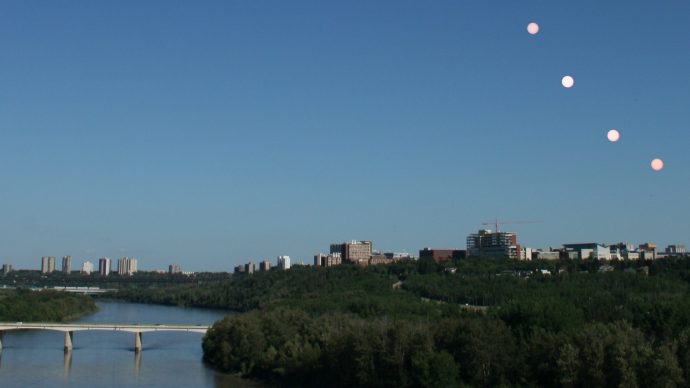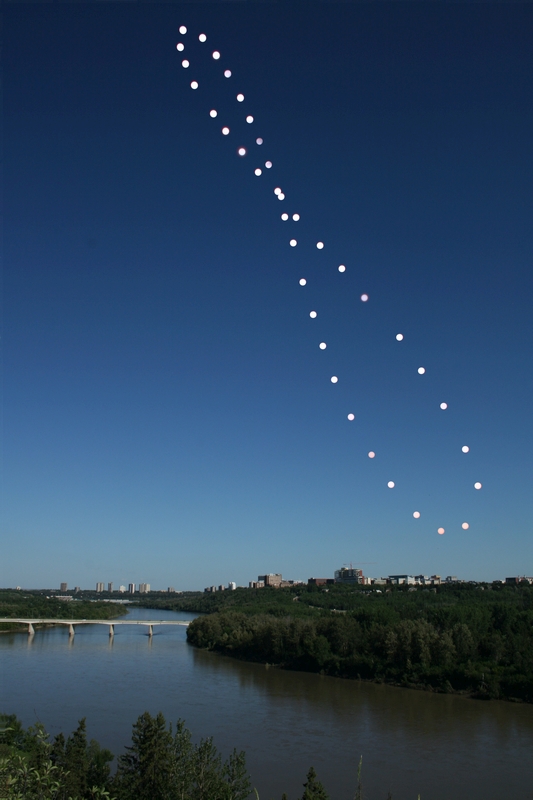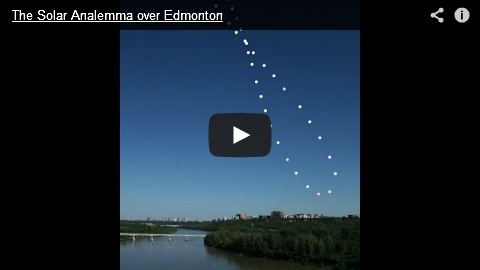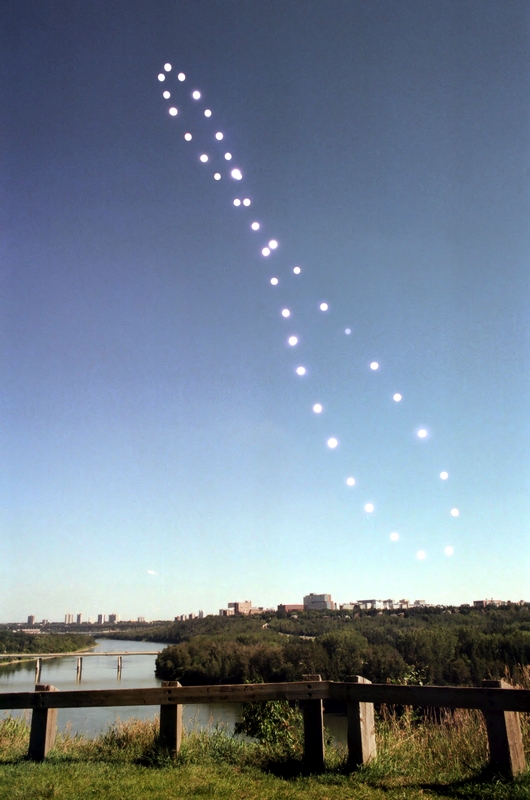The Solar Analemma over Edmonton
By Luca Vanzella
If observed at the same time each day, in the course of a year, the Sun’s position in the sky traces a figure-8 shaped curve called the “analemma”. The analemma is produced by the combined effects of the Earth’s tilted axis of rotation and its variation in speed along its elliptical orbit around the Sun. Over the year, the Earth’s axial tilt shifts the Sun’s position north/south and the Earth’s elliptical orbit shifts it east/west. Solstices correspond to the top and bottom of the figure-8, indicating the northern and southernmost limits of the Sun in the sky. The cross-over point on the curve is around both April 12 and August 30 as the Sun’s apparent position ascends and descends respectively. The analemma curve is also a graphical representation of the equation of time which describes the difference between sundial time (apparent solar time) and clock time (mean solar time).
Phil Plait has a great article describing what causes the analemma and analemma.com explains all of this in detail with nice animations.
In 1979, Sky & Telescope editor Dennis di Cicco produced the first photograph of the analemma – recorded on a single piece of film. Di Cicco’s photograph started the “sport” of capturing the solar analemma as a single image, that continues to this day. For many years, the quest was to capture the analemma on a single frame of film – a very difficult photographic challenge as many things can go wrong over the course of a year. Digital photography has made things a bit easier since it is more forgiving of mistakes, but capturing the analemma digitally is still difficult. Astronomy Picture of the Day has featured images of the solar analemma several times and a web search finds many examples.
In 2009, Astronomy Picture of the Day published an unusual analemma image by Cenk E. Tezel and Tunç Tezel. In the description of how they accomplished it, Tunç Tezel said “I have to express my respect to single-film, multi-exposure achievers of the image, starting with Dennis DiCicco and ending with Anthony Ayiomamitis. Or should it be apologies?” I had been thinking about taking on the analemma challenge when I read Tezel’s remark and I thought “Ending with? Not so fast, Tunç. I have a film camera that is now just sitting in a closet. Let me see if I can’t add another film-based analemma to the pantheon.”
And so began my saga to capture the analemma. Why a saga? Because, photographing the analemma is difficult, whether you do it on film or with a sensor.
- It takes about a year to do it, which requires commitment to a shooting schedule for a long time. Unless you have a location that can safely remain unattended and a fully automated setup, a flexible personal schedule is needed to take advantage of days when the Sun is visible, since it may be cloudy on a scheduled shooting date. An assistant may be required if absences prevent you from taking an image.
- Dedicating a camera and mount to a fixed position or repeating a fixed position with a portable mount is fraught with dangers. For example, in Edmonton, where I live, winters present special challenges since snow and ice tend to accumulate on horizontal surfaces.
- You need a clear sky near the Sun every week to two weeks or so, throughout the year. The window in which to capture a solar image is very narrow – a specific time of day and only that time of day will do.
- With film, a single error means you have to restart the whole thing. Even worse, you may not realize that an error has occurred until the film is developed. With digital, an error can be overcome by imaging again on the next available opportunity, but the opportunity may not present itself soon enough due to weather.
- Murphy is always hanging around and there are ample opportunities to make a mistake.
I mulled and pondered about where and when to shoot the analemma and by June 2010, I was ready. Since this was going to be an “old school” analemma photo, I decided use my old but trusty Canon A-1 film camera and my equally old and classic 28mm wide angle lens. I figured my chance of success was 50-50 in one year but I ought to get it in two years. I figured wrong.
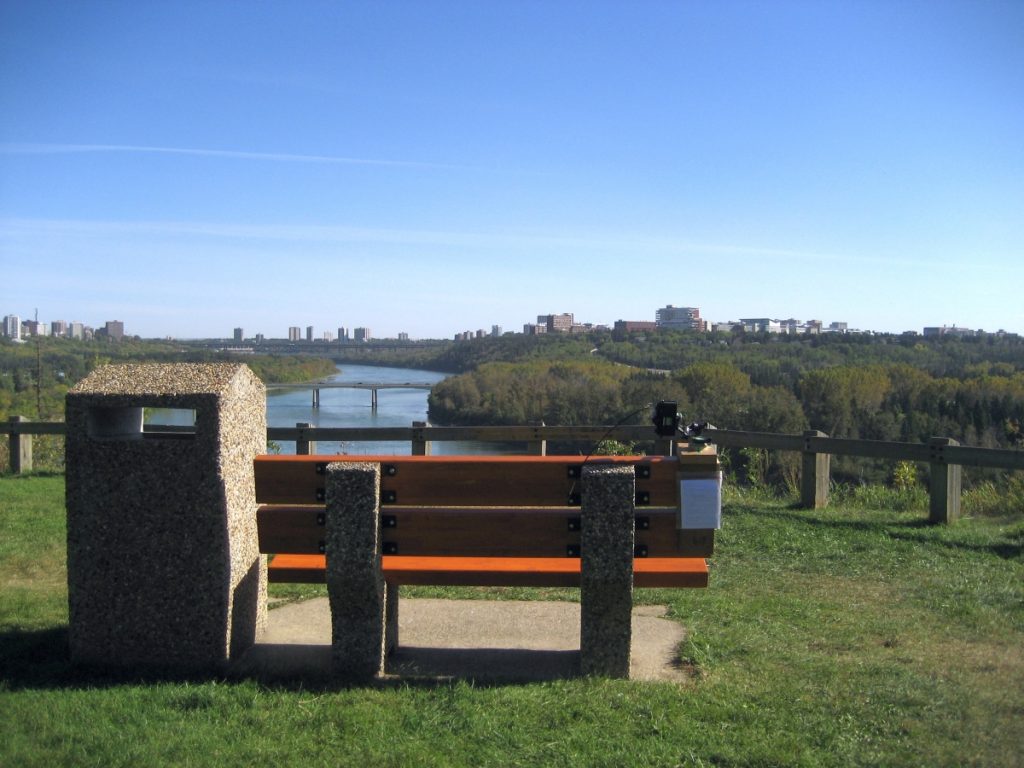
Choosing a location from which to photograph the analemma took a while. I couldn’t do it from my yard (the most convenient location) because there are too many trees. I tried to find a location that put the iconic Alberta Legislature Building in the foreground but I could not find one that was suitable for distance, ease of access and ease of repeatable camera position (this turned out to be a good thing, since the Legislature Dome eventually underwent a year-long restoration during which it was not photogenic). Edmonton’s exquisite river valley was my next choice and finding a location proved to be easy. The lookout at St. George’s Crescent immediately came to mind, as it has a very fine view of the river, valley and some skyline, and I had photographed several moonrises over the years from that location.
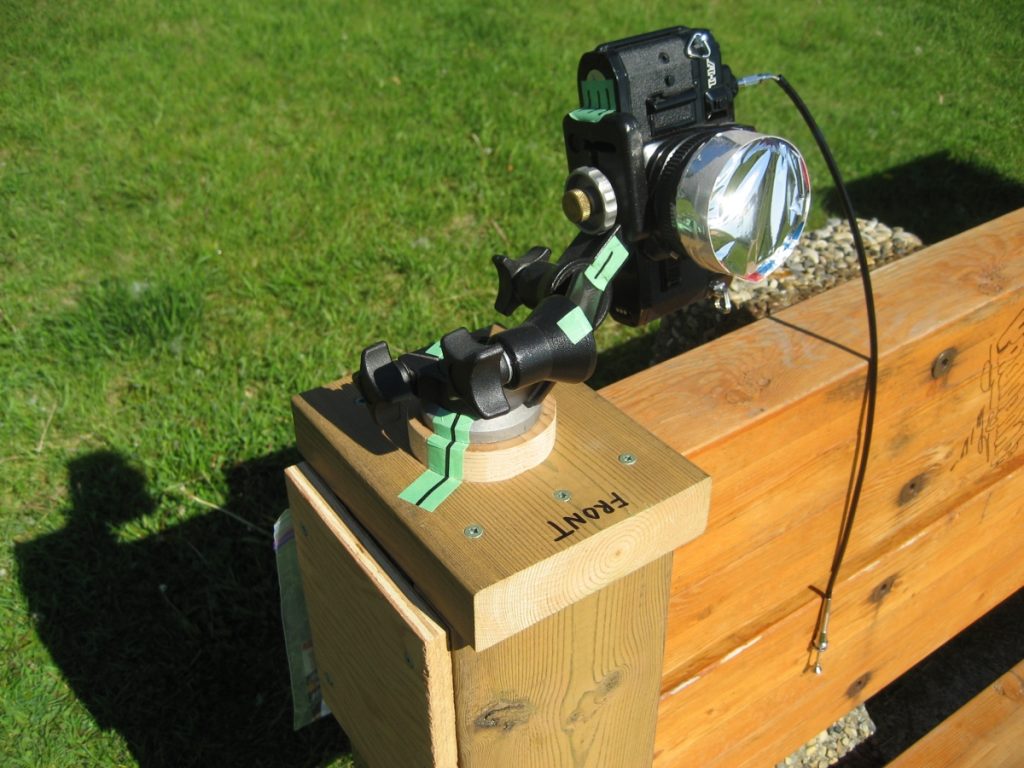
The location’s best feature was an extremely sturdy park bench that would serve as a stable base for a custom camera mount, thanks to the City of Edmonton parks department. Snow clearing would be required in winter, but because the bench was bolted onto a concrete pad, I figured it would not move. I constructed a mount that would sit on the back of the park bench using one of amateur astronomy’s time-honored materials – wood, in this case, scraps of pressure-treated 2×6 lumber. I bolted a simple but very versatile Manfrotto tripod head to the wooden mount and secured the camera to the head. I made a solar filter using Baader filter material and more classic materials – cardboard and tape.
Selecting the time of day for the solar images was another important factor to consider. Since I don’t have an extremely wide angle lens, a morning or afternoon time was needed to slant the analemma so it fit, along with some foreground, within a frame of 35mm film when using a 28mm lens. In Edmonton, mornings are typically better than afternoons for chances of clear skies. I chose a morning time that kept the Sun above the horizon all year, including the depths of winter, when the Sun sits low above the horizon. Too early would increase the chances of clouds or steam plumes covering the low winter Sun. I selected 09:30 AM as the compromise between a low winter Sun and a slanted analemma curve.
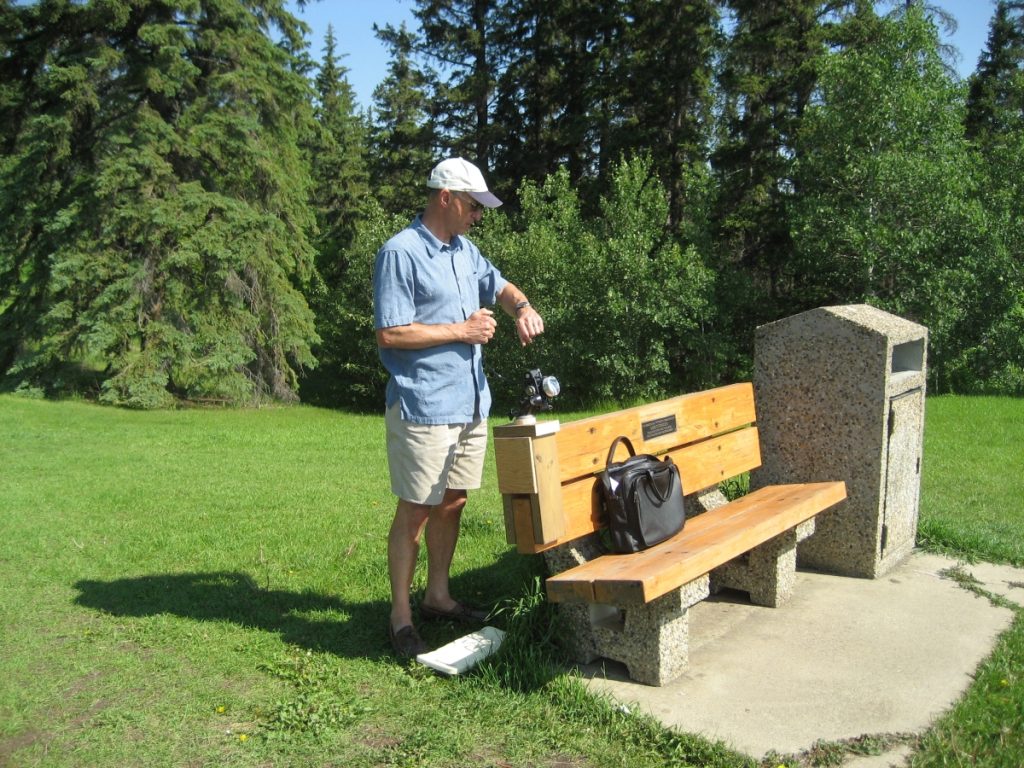
The First Attempt (2010-11)
I started the analemma on June 20, 2010 at 09:30 MST. The camera was loaded with Kodak Gold 200 film and I shot the solar images at 1/60 sec at f/22. Things went well until late December, when I noticed that my choice of 09:30 AM put the Sun at 3.5 degrees altitude around the winter solstice. At this low altitude, the Sun was occasionally obscured by steam plumes from a power plant at the University of Alberta, which was in the foreground. On December 21, a planned shooting date, I discovered that the bolt holding the tripod head on the wooden mount had loosened. Even though I had used masking tape to draw alignment marks on connections and movement axes, I had missed marking a connection between rotating sections of the tripod head. The first hard choice had to be made: start all over or attempt to realign the mount. I found photos I had taken of the original setup and used scratch marks (!) on the head and mount to realign the camera. Thinking it would be close enough, I rebolted the head to the mount, added the missing alignment tape, and forged ahead.
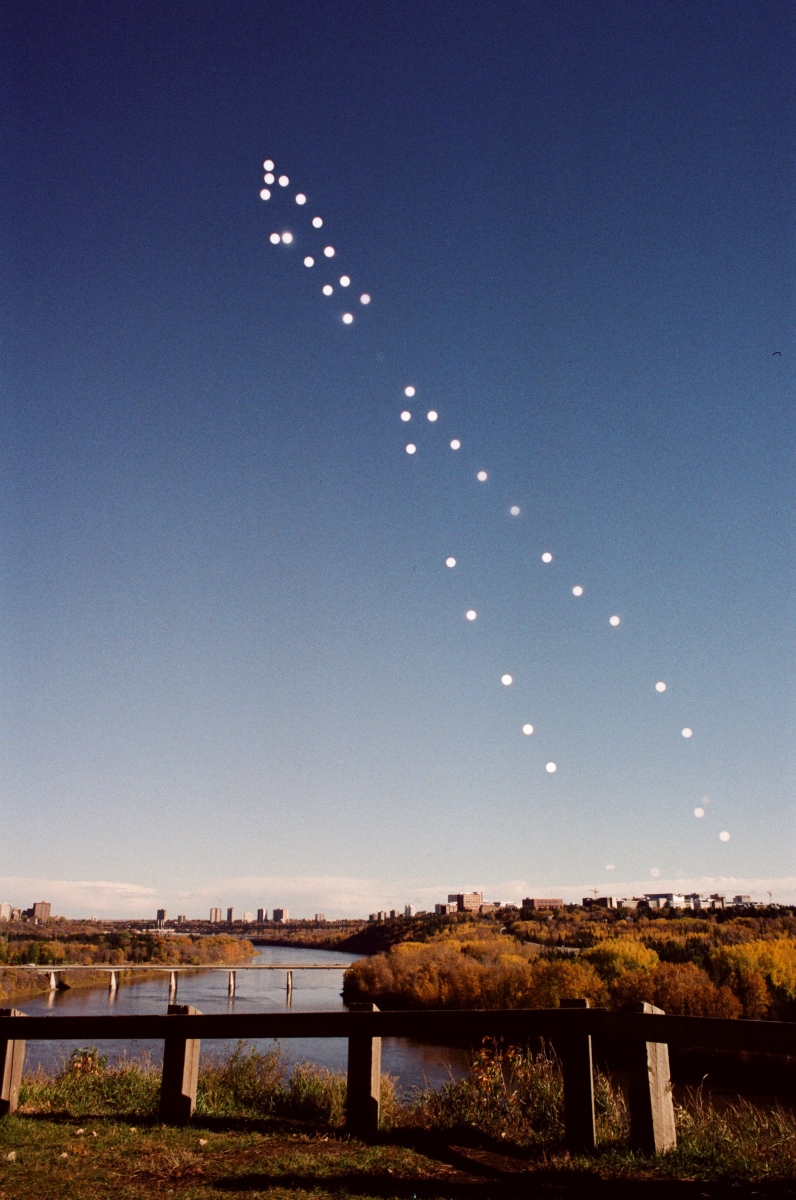
On June 5, 2011, after taking 43 solar images and 1 foreground image, the first attempt was complete. It had failed. The loose bolt on the mount had shifted 2-3 sun exposures before I discovered it was loose. Also, a slight wiggle in the way the mount sat on the bench distorted the shape a bit. To top it off, something happened completely unknown to me, on the 3rd or 4th solar exposure to shift the Sun’s apparent position. As an aside, I recorded the temperature on all shooting dates – it ranged from a brisk -26 C to a balmy + 20 C.
I must take a moment now to acknowledge my astrophotographer friend Alister Ling who did not roll on the floor laughing when I first told him about my quest, acted as a sounding board for my ideas about how to do it, and who kindly stepped in when an absence prevented me from taking two solar exposures. As in many things, having a buddy can be paramount to success.
The Second Attempt (2011-12)
I started the second attempt on June 22, 2011 at 09:45 MST. The camera was again loaded with Kodak Gold 200 film and I shot the solar images at 1/60 sec at f/22. I moved the time to 09:45 AM to put the lowest Sun altitude at 5.2 degrees, comfortably above the steam plumes of winter. I also reduced the number of solar exposures a bit to reduce the effort of the project. All tape marks were double checked and by now I had developed a consistent technique for sitting the mount on the bench.
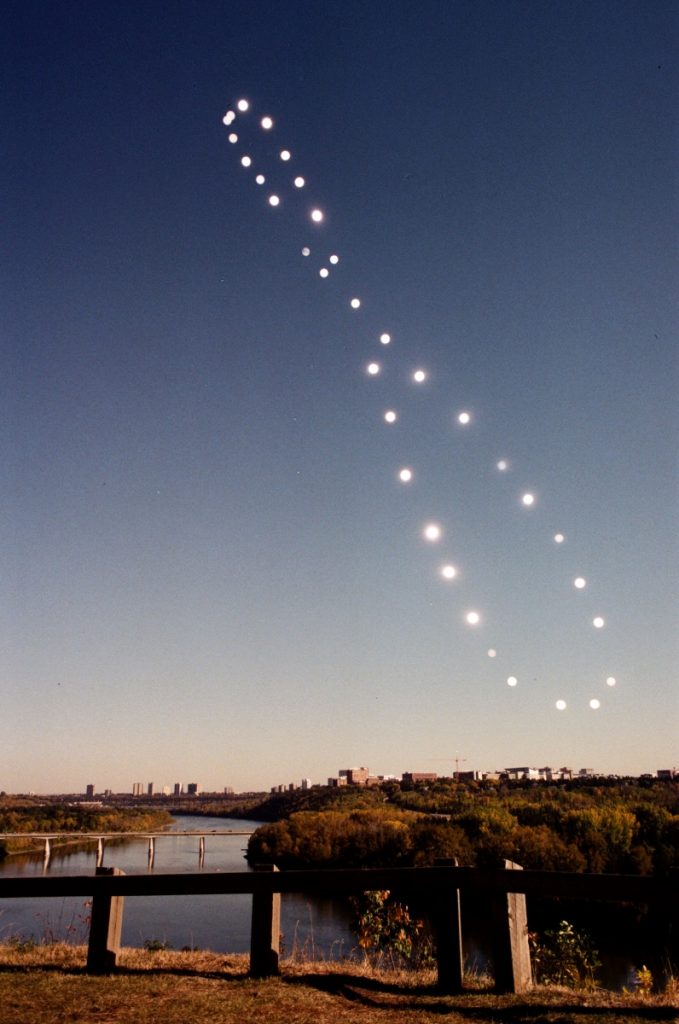
On June 3, 2012, after taking 34 solar images and 1 foreground image, and with no obvious problems occurring, the second attempt was complete. It had failed. Somehow, the very first solar image was shifted relative to all of the others, even though I had not detected any tape marks moving. Also, at another time during the year, the camera had moved on its base plate, so I realigned it using the tape marks – there were no position anomalies because of it. But there was that one position shift that occurred right after the first exposure! A pretty nice result, but not good enough. Thanks again to Alister Ling for stepping in for two solar exposures in my absence. The temperature range for this attempt? -17 C to + 23 C.
The Third Attempt (2012-13)
The third attempt began on June 20, 2012 at 09:45 MST. By this time, Kodak had filed for bankruptcy and I could not find Kodak film, so I switched to Fuji Superia 200 film (while wondering how long film was going to last). I shortened the solar exposures to 1/125 sec at f/22, to avoid halos around the Sun caused by thin cirrus clouds. Everything was good to go and the procedure had become quite routine.
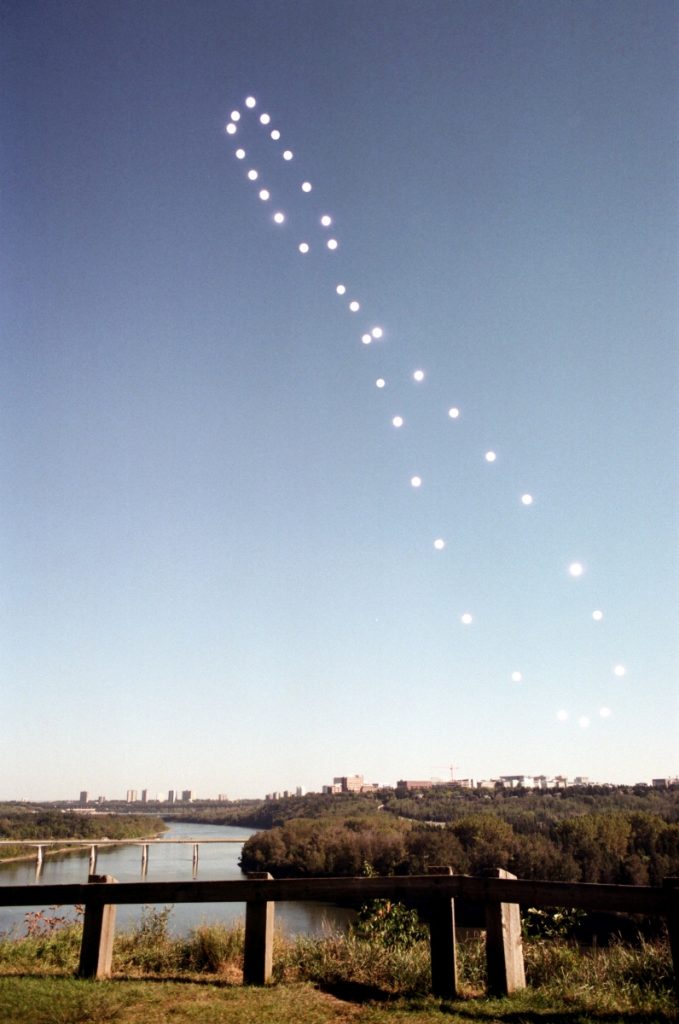
On June 4, 2013, after taking 34 solar images and 1 foreground image, but this time with an obvious problem occurring, the third attempt was complete. It failed because on February 10, 2013, the camera had somehow again shifted on its base plate and the tripod head had twisted a bit on the wooden mount. I had used the tape marks to realign the mount, but I didn’t do it well enough since 12 solar images had shifted up. Even though this would be fairly easy to digitally correct in post with a scan of the negative, it was still not good enough for the classic “all-on-one frame-of-film” analemma. Sigh. Once again, thanks to Alister for taking one solar exposure in my absence. This attempt had a temperature range of -20 C to +24 C.
This film business was starting to get me down, so I started thinking about a digital analemma sequence. I had an older DSLR camera that I could dedicate to the cause, but that would leave the film quest incomplete. One day, I happened to see again Tom Matheson’s excellent Analemma Over New Jersey timelapse movie. Matheson’s movie inspired me to attempt a fourth analemma sequence, but this time there would be two cameras employed. Going digital would almost guarantee that I could successfully complete it in one year, but digital also meant that I could create a timelapse video of the Sun’s position on the analemma curve, that also showed the changes of the four seasons. And while I was at it I thought, why not try the film-based analemma again? Doing both in parallel would not add much effort. Hah!
The First (and Final) Digital Analemma Attempt (2013-14)
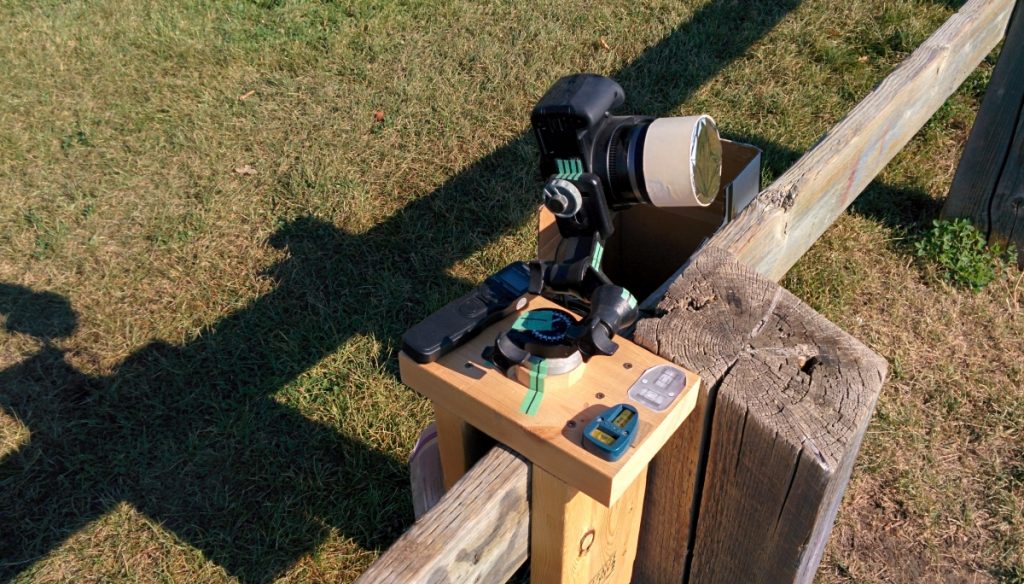
Since the digital sequence would also showcase the changes of the four seasons in Edmonton, I wanted a better view of the river valley foreground. Just in front of the sturdy park bench I had been using for 3 years was a sturdy fence, so I built another wooden mount that could sit on the top rail of the fence. Another Manfrotto tripod head, another Baader solar filter, more tape marks, … well, you get the idea.
On June 21, 2013 at 09:45 MST, I started the project to image the solar analemma with a digital camera. The project had two objectives: (1) capture the figure-8 curve of the Sun’s position over a year above an Edmonton foreground in a single composite image, and (2) capture the changes of the four seasons in Edmonton in a timelapse movie with the figure-8 of the analemma evolving as the seasons progressed. I used a Canon XTi camera with a 18mm focal length lens, ISO 200, solar images 1/100 sec at f/11 and foreground images at various exposures. Things generally went well with the digital camera. The ability to review each image for problems meant that images with errors could be discarded without compromising the attempt. Repeating the exact placement of the mount on the fence proved a bit more problematic than placement on the bench, so some tiny position adjustments were needed in post.
The digital sequence ended on June 2, 2014 after capturing 38 solar images and several foreground images per month for the seasonal changes. It had succeeded! (The temperature range: -29 C to +24 C.)
The Solar Analemma Over Edmonton
This is the composite digital image, consisting of 38 separate solar exposures from June 21, 2013 to June 2, 2014. Each solar image was taken at 9:45 AM at St. George’s Crescent in Edmonton, Alberta, Canada. The solar images were digitally combined with a single foreground image taken at the same location on July 3, 2013.
All images were taken using a Canon XTi camera with a 18mm focal length lens. The solar images were typically at 1/100 sec at f/11, ISO 200 (sometimes a different exposure was used due to clouds). The camera was mounted on a tripod head affixed to a custom wooden mount that was placed on a fence.
The Solar Analemma over Edmonton (digital).
Click to analemmate (on Flickr).
The Solar Analemma Over Edmonton – Timelapse Movie
This is the timelapse movie illustrating the Sun’s motion on the analemma curve, from June 21, 2013 to June 2, 2014. Each solar image was taken at 9:45 AM at St. George’s Crescent in Edmonton, Alberta, Canada. The foreground images showing the changes of the four seasons were taken at the same location, some at 09:45 AM and others in the afternoon.
The Fourth Film Attempt (2013-14)
I conducted the fourth film attempt in parallel with the digital sequence, starting on June 21, 2013. Since the digital camera images were going to be showing more of the river valley foreground, and therefore less sky, I decided to delay the shooting time of the film camera by 5 minutes to 09:50 MST. I figured I needed 5 minutes to shoot the digital images, stow the digital camera and set up the film camera. Five minutes would lift the film analemma a bit but there was enough room in the film frame to accommodate.
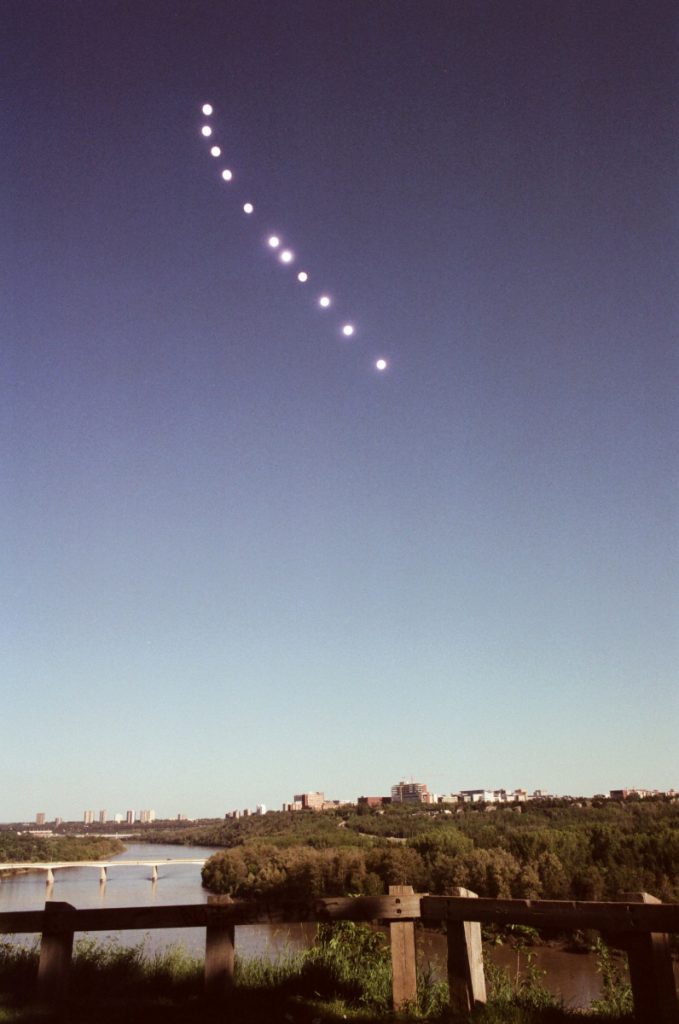
Fuji film was still available so once again I used Superia 200 film. I modified the solar exposures a bit, using 1/125 sec at f/22 in the upper loop of the analemma and 1/125 sec at f/19 in the lower loop (to make the lower solar images brighter against the lower sky which was always a bit whiter due to the color gradient in clear blue skies. To ensure that the camera would not move against the base plate of the tripod head (it had moved on two prior attempts), I hot glued the bottom of the camera to the base plate.
On September 19, 2013, after three years of no issues with the park bench, I found that the City had replaced bench’s seat and back (as part of routine maintenance)! Although the frame in the viewfinder appeared very similar to before, the wooden mount moved around more on the back of bench. I had to assume that there would be a position anomaly. At least this problem had occurred only 3 months into the sequence and I knew about it. The parallel, digital analemma sequence still had 9 months to go, so sadly, I advanced the film to the next frame.
The Fifth Film Attempt (2013-14)
I reassembled the mount for a tighter fit on the park bench and the skies cooperated, so I was able to start the fifth film attempt the next day, on September 20, 2013. Things went smoothly except for one time.
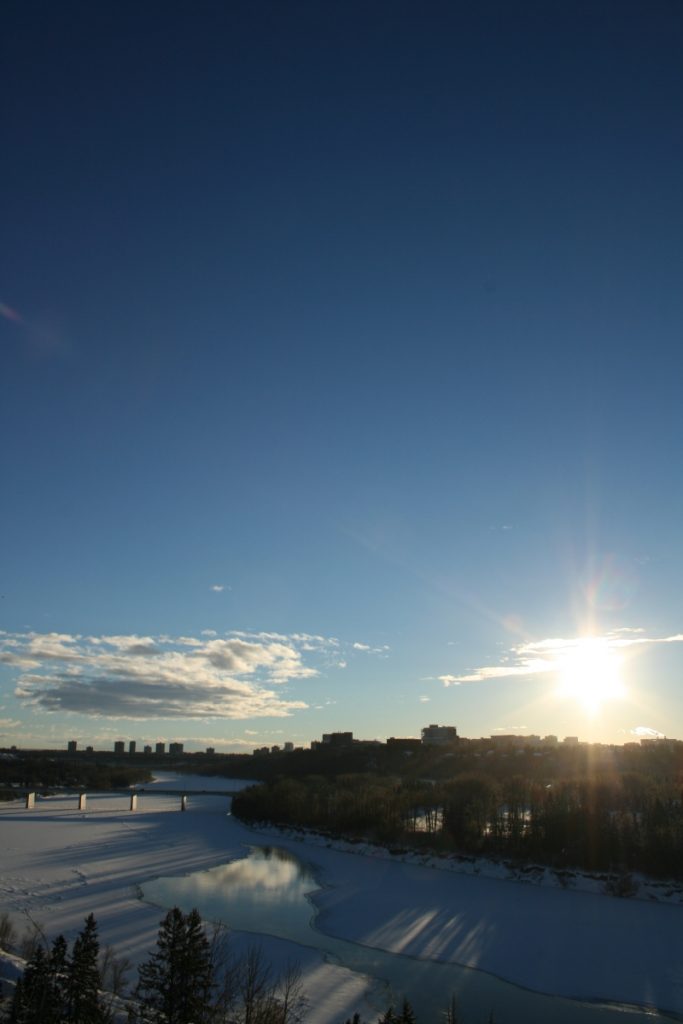
January 4, 2014 was a clear winter day, the first clear day since December 22. With the temperature hovering at a cool -22 C, as I stood in the deep snow, the appointed time arrived and I fired the shutter. Nothing. Thinking I had forgotten to reset the shutter on the previous shot, I quickly reset it. Fire. Nothing. Press the battery test button. Nothing. The camera battery had died! It had been so long since I had needed to replace the camera battery (several years in fact) that I had forgotten to periodically check it. Luckily, the next day was also clear, so I was able to get the solar image at the bottom of the analemma, in what some of us call “Edmonton Cold”, that is, clear with a temperature of -29 C and a windchill of -39 C (maybe not so lucky). There were major steam plumes from University of Alberta power plant, but the Sun was just above them.
On September 13, 2014, after taking 38 solar images and 1 foreground image, my fifth attempt at a film-based analemma was complete. It succeeded. Well, mostly. For reasons I have not been able to determine, one of the solar images ended up slightly out of place. No obvious errors had occurred and none of the tape marks had ever moved. Perhaps I had seated the mount on the bench incorrectly without noticing. Unlike the other four attempts, in which position anomalies had explanations, this one was a mystery. But after fours years and three months of trying, and with a successful digital analemma in the bag, I had had enough. A simple edit of the scanned negative, equivalent to the dodge and burn darkroom techniques, fixed the small error. And oh yeah, the temperature range for this attempt was -29 C (-39 C with windchill) to +28 C.
The Solar Analemma Over Edmonton
This is the composite film image, consisting of 38 separate solar exposures from September 20, 2013 to September 13, 2014 and 1 foreground exposure on August 11, 2014, all on a single frame of film. Each solar image was taken at 9:50 AM at St. George’s Crescent in Edmonton, Alberta, Canada.
All images were taken using a Canon A-1 film camera with a 28mm focal length lens. The solar images were typically at 1/125 sec at f/22, ISO 200. The camera was mounted on a tripod head affixed to a custom wooden mount that was placed on a park bench.
The Solar Analemma over Edmonton (on a single frame of film).
Click to analemmate (on Flickr).
© 2014 Luca Vanzella.
P.S. As far as I know, this is only the second time the solar analemma has been photographed from a location in Canada. In 2000-2001, Steve Irvine of Keppel Henge fame, produced on film, what I believe is the first analemma from Canada.
